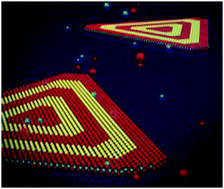当前位置:
X-MOL 学术
›
Chem. Soc. Rev.
›
论文详情
Our official English website, www.x-mol.net, welcomes your
feedback! (Note: you will need to create a separate account there.)
Chemical synthesis of two-dimensional atomic crystals, heterostructures and superlattices
Chemical Society Reviews ( IF 40.4 ) Pub Date : 2018-03-12 00:00:00 , DOI: 10.1039/c7cs00887b Peng Chen 1, 2, 3, 4, 5 , Zhengwei Zhang 1, 2, 3, 4, 5 , Xidong Duan 1, 2, 3, 4, 5 , Xiangfeng Duan 1, 2, 3, 4, 5
Chemical Society Reviews ( IF 40.4 ) Pub Date : 2018-03-12 00:00:00 , DOI: 10.1039/c7cs00887b Peng Chen 1, 2, 3, 4, 5 , Zhengwei Zhang 1, 2, 3, 4, 5 , Xidong Duan 1, 2, 3, 4, 5 , Xiangfeng Duan 1, 2, 3, 4, 5
Affiliation

|
Two-dimensional atomic crystals (2DACs) have attracted intense recent interest. With a nearly perfect crystalline structure and dangling-bond free surface, these atomically thin materials have emerged as a new material platform for fundamental materials science and diverse technology opportunities at the limit of single atom thickness. Over the past decade, a wide range of 2DACs has been prepared by mechanically exfoliating bulk layered crystals, which has fueled the rapid progress of the entire field in terms of fundamental physics and basic device demonstrations. However, studies to date are largely limited to mechanically exfoliated flakes, which are clearly not scalable for practical applications. The chemical synthesis of these materials has been lagging far behind fundamental property investigations or novel device demonstrations, which limits further progress of the field. To explore the full potential of 2DACs requires a robust synthesis of these atomically thin materials and scalable construction of complex heterostructures with designed spatial modulation of chemical compositions and electronic structures. The extreme aspect ratio and highly delicate nature of the atomically thin crystals pose a significant synthetic challenge beyond traditional bulk crystals and have motivated considerable efforts worldwide. Here we will review the recent advances, challenges and future perspective of the chemical synthesis of 2DACs, heterostructures and superlattices.
中文翻译:

二维原子晶体,异质结构和超晶格的化学合成
二维原子晶体(2DAC)最近引起了人们的极大兴趣。这些原子薄的材料具有近乎完美的晶体结构和悬空的自由键表面,已成为基础材料科学和单一原子厚度限制下的各种技术机遇的新材料平台。在过去的十年中,通过对大块分层晶体进行机械剥落制备了各种2DAC,这推动了整个领域在基础物理学和基本器件演示方面的快速发展。然而,迄今为止的研究主要限于机械剥落的薄片,其显然不能在实际应用中扩展。这些材料的化学合成远远落后于基本性能研究或新颖的设备演示,这限制了该领域的进一步发展。为了探索2DAC的全部潜力,需要对这些原子薄材料进行稳健的合成,并通过设计的化学成分和电子结构空间调制,对复杂的异质结构进行可扩展的构造。原子薄晶体的极高的纵横比和高度精细的特性对合成提出了超越传统块状晶体的重大挑战,并在全球范围内做出了巨大的努力。在这里,我们将回顾2DAC,异质结构和超晶格化学合成的最新进展,挑战和未来前景。为了探索2DAC的全部潜力,需要对这些原子薄材料进行稳健的合成,并通过设计的化学成分和电子结构空间调制,对复杂的异质结构进行可扩展的构造。原子薄晶体的极高的纵横比和高度精细的特性对合成提出了超越传统块状晶体的重大挑战,并在全球范围内做出了巨大的努力。在这里,我们将回顾2DAC,异质结构和超晶格化学合成的最新进展,挑战和未来前景。为了探索2DAC的全部潜力,需要对这些原子薄材料进行稳健的合成,并通过设计的化学成分和电子结构空间调制,对复杂的异质结构进行可扩展的构造。原子薄晶体的极高的纵横比和高度精细的特性对合成提出了超越传统块状晶体的重大挑战,并在全球范围内做出了巨大的努力。在这里,我们将回顾2DAC,异质结构和超晶格化学合成的最新进展,挑战和未来前景。
更新日期:2018-03-12
中文翻译:

二维原子晶体,异质结构和超晶格的化学合成
二维原子晶体(2DAC)最近引起了人们的极大兴趣。这些原子薄的材料具有近乎完美的晶体结构和悬空的自由键表面,已成为基础材料科学和单一原子厚度限制下的各种技术机遇的新材料平台。在过去的十年中,通过对大块分层晶体进行机械剥落制备了各种2DAC,这推动了整个领域在基础物理学和基本器件演示方面的快速发展。然而,迄今为止的研究主要限于机械剥落的薄片,其显然不能在实际应用中扩展。这些材料的化学合成远远落后于基本性能研究或新颖的设备演示,这限制了该领域的进一步发展。为了探索2DAC的全部潜力,需要对这些原子薄材料进行稳健的合成,并通过设计的化学成分和电子结构空间调制,对复杂的异质结构进行可扩展的构造。原子薄晶体的极高的纵横比和高度精细的特性对合成提出了超越传统块状晶体的重大挑战,并在全球范围内做出了巨大的努力。在这里,我们将回顾2DAC,异质结构和超晶格化学合成的最新进展,挑战和未来前景。为了探索2DAC的全部潜力,需要对这些原子薄材料进行稳健的合成,并通过设计的化学成分和电子结构空间调制,对复杂的异质结构进行可扩展的构造。原子薄晶体的极高的纵横比和高度精细的特性对合成提出了超越传统块状晶体的重大挑战,并在全球范围内做出了巨大的努力。在这里,我们将回顾2DAC,异质结构和超晶格化学合成的最新进展,挑战和未来前景。为了探索2DAC的全部潜力,需要对这些原子薄材料进行稳健的合成,并通过设计的化学成分和电子结构空间调制,对复杂的异质结构进行可扩展的构造。原子薄晶体的极高的纵横比和高度精细的特性对合成提出了超越传统块状晶体的重大挑战,并在全球范围内做出了巨大的努力。在这里,我们将回顾2DAC,异质结构和超晶格化学合成的最新进展,挑战和未来前景。











































 京公网安备 11010802027423号
京公网安备 11010802027423号